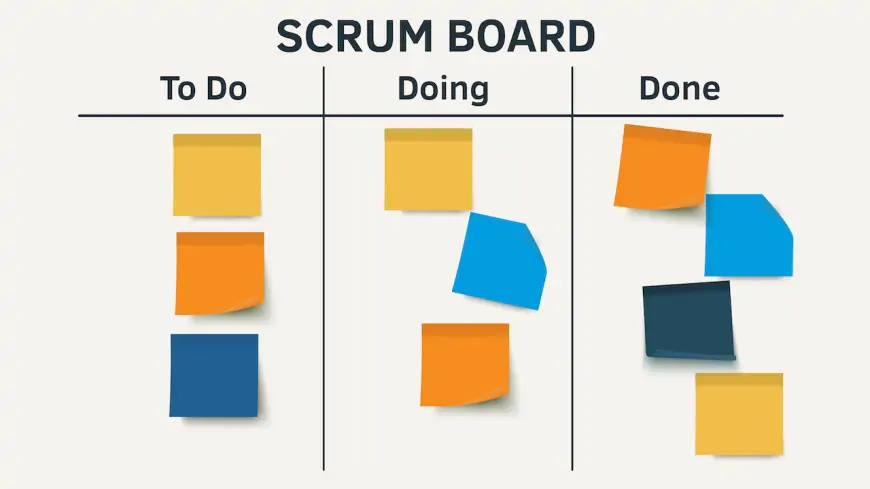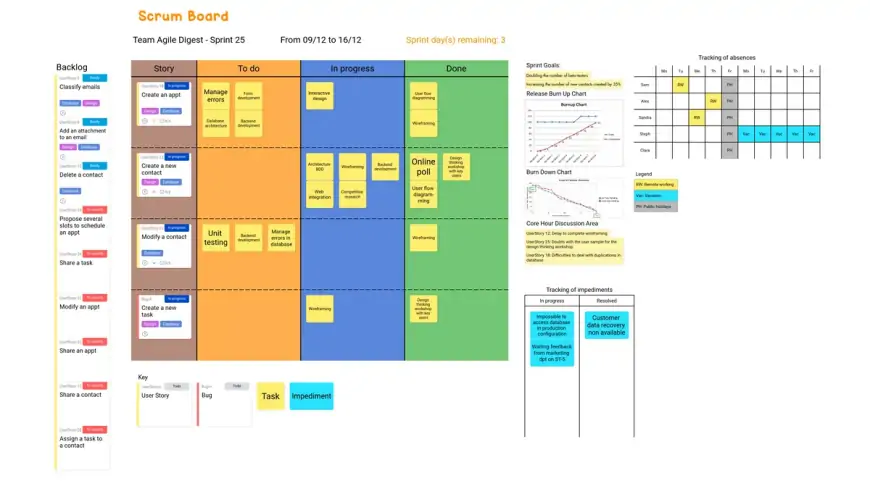What is a Scrum board? A complete guide 2024
A Scrum board is a visual tool used in Agile project management to track the progress of tasks during a sprint, fostering collaboration and transparency.

What is a Scrum board?
A Scrum board serves as a visual tool for tracking the progress of a Scrum sprint, typically displayed on a whiteboard or wall. The basic structure consists of three vertical columns: "To Do," "In Progress," and "Done," with tasks represented by Post-it Notes or stickies. The simplicity of the Scrum board allows for customization, with the ability to add more columns or sticky notes as needed to suit project requirements.
The versatility of the Scrum board makes it adaptable to various project types, whether long or short-term, and can be tailored to meet specific project needs. Key components for successful management include a small and collaborative Scrum team, a well-defined sprint and sprint backlog, and a solid understanding of the Scrum framework and methodology.
Scrum board example

Scrum board pros and cons
Pros
- User-friendly: Scrum boards are intuitive and straightforward to use, facilitating excellent project management. When integrated with the entire Scrum framework, they enhance team efficiency, creativity, and productivity. Scrum boards can be created both physically and digitally to suit project needs and team preferences.
- Comprehensive, flexible, and responsive: By clearly indicating tasks and their real-time status during a sprint, Scrum boards significantly reduce the risk of overlooked tasks or unaddressed issues. They offer flexibility and adaptability to changing project requirements.
- Promotes collaboration: Scrum fosters teamwork, collaborative problem-solving, and accountability among team members. While individuals may work on specific tasks independently, regular updates on the Scrum board ensure transparency and facilitate the sharing of skills and knowledge. This collaborative approach helps identify and address issues promptly, creating a cooperative project environment.
Cons
- Steep learning curve: Understanding and implementing the Scrum framework require time and effort. Without adequate knowledge or commitment to learning, misunderstandings and implementation challenges may arise. The terminology associated with Scrum, originally developed for software developers, may be daunting for individuals unfamiliar with the framework's concepts.
- Initial expenses: Although Scrum itself is a cost-effective project management system, setting up a Scrum board may incur upfront costs for supplies or online services. These initial investments may be necessary for effective implementation but could pose a barrier for teams with limited resources.
Scrum framework and terminology
When delving into Scrum, you'll encounter various terms that may seem daunting at first. However, most simply define roles or aspects of project management you likely already know. Here's a breakdown:
Scrum values
Aligned with Agile, key Scrum values include transparency, inspection, and adaptation. These values ensure clarity in tasks, regular progress review, and readiness to adjust in response to challenges.
The sprint
A Scrum sprint is a designated period to achieve project goals or components. Each sprint focuses on specific project elements, with the team committing to a set amount of work. Sprints typically last two to four weeks and involve various events:
- Sprint planning: Detailed discussion to set sprint goals.
- Daily Scrum: Brief daily meeting to plan tasks and review progress.
- Sprint review: Evaluation of sprint outcomes and areas for improvement.
- Sprint retrospective: Reflective session on the sprint's successes and areas for enhancement.
Scrum artifacts
- Product backlog: A comprehensive project to-do list.
- Sprint backlog: Specific tasks from the product backlog for the current sprint.
- Increment: Tasks successfully completed within a sprint.
The Scrum team
- Product owner: Oversees sprint goals and task definition.
- Scrum master: Ensures adherence to Scrum principles and facilitates Scrum events.
- Development team: Executes tasks outlined in the sprint backlog, aiming for self-organization and collaboration.
Consider creating a Scrum board?
If you seek a user-friendly and visual method for project management that fosters accountability, adaptability, and teamwork within a small group, then creating a Scrum board is advisable. Moreover, adopting a Scrum board entails employing a comprehensive, thoroughly developed framework backed by extensive methodological and theoretical resources.
In essence, Scrum serves as an excellent option for organizations and teams requiring a dependable and effective project management system. Even for individuals seeking to organize tasks, utilizing a Scrum board could offer added advantages, even without implementing the full Scrum framework.












































